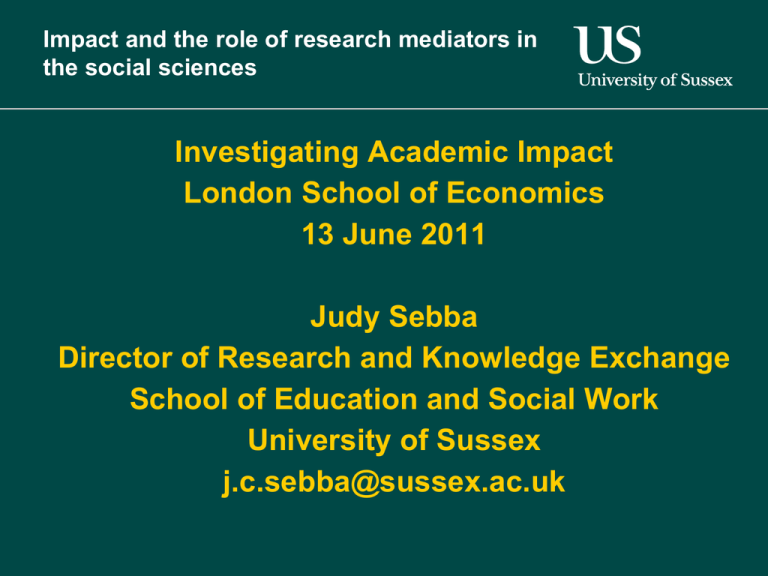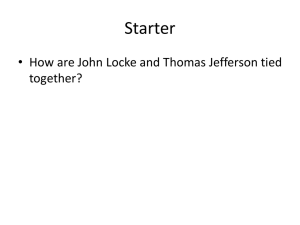Investigating Academic Impact London School of Economics 13 June 2011 Judy Sebba
advertisement

Impact and the role of research mediators in the social sciences Investigating Academic Impact London School of Economics 13 June 2011 Judy Sebba Director of Research and Knowledge Exchange School of Education and Social Work University of Sussex j.c.sebba@sussex.ac.uk Why is this important? • Economic imperative to justify public spending: e.g. child with conduct disorder aged 10 cost public services in England £70k by age 27, compared to £7k for others – yet evidence on preventing these problems is ignored (Scott, Knapp et al, 2001); • Moral imperative to ensure those providing services do so informed by the best possible evidence; • Academic imperative - REF impact case studies & statements; significance of outputs; Funding applications require impact plans; ESRC requires impact report 12 months after the end date of the award. 2 What is the problem? • Policy makers rank academic research well below special advisers (media background), experts and think tanks as sources of evidence (Campbell et al 2007; Rich 2004; Rigby 2005); • Policy makers often regard research findings as impenetrable, ambiguous, conflicting, insignificant, untimely or only partially relevant. In turn, they display confusion about what constitutes evidence and its role (Rickinson, Sebba & Edwards 2011). 3 • Confusion about evidence: The honourable member for Braintree cited evidence from the Sun, so I want to refer to a recent edition of the British Medical Journal (ex LibDem MP Evan Harris in the parliamentary debate on cancer) Terminology Attempt to categorise terminology from least to most impact intended: 1.‘Knowledge transfer’ & ‘dissemination’ - movement of evidence from one place to another to increase access, without directly attempting to simplify, interpret or translate findings (though might do); 2.‘Knowledge translation’, ‘knowledge mobilisation’, ‘research brokerage’ and ‘research mediation’ imply intention to intervene in the process e.g. summarising, interpreting, etc., to increase use but do not of themselves, provide evidence of use; 3. ‘Impact’, ‘Research use’, ‘research utilisation’ and ‘implementation’ imply evidence of direct influence on policy or practice. Might depend on stakeholders’ retrospective perceptions, but goes beyond rhetoric. 4 Note: many examples of overuse of poor research with devastating effects. Overuse, underuse or abuse? What are research mediators: some definitions • Mediation is undertaken by funders, media, policy analysts, educators, lobby groups, think tanks, policy advisers, etc; • Knowledge brokering links decision makers and researchers, facilitating their interaction so that they are able to better understand each other's goals and professional cultures, influence each other's work, forge new partnerships, and promote the use of research-based evidence in decision-making. (Canadian Health Services Research Foundation) 5 • Haas (2007, p. 68) offers: Think tanks are defined generally as organizations that have significant autonomy from governmental interests and that synthesize, create, or disseminate information, research, ideas, or advice to the public, policymakers…and the press. Who are the research mediators and what do they do? (Ball & Exley 2010) • Nodes (e.g. Policy Exchange, IPPR, DEMOS, etc) & ‘interlockers’ (e.g. Mulgan, Miliband) who act as ‘bridges’; • Many have multiple positions, sequentially & concurrently, as trustees for each others’ organisations, sit on each others’ councils, write, speak and ‘appear on platforms’ at each other’s events (p.155); • Leads to a consensus building of ideas and positions; • illustrates not only a set of flows and a connectedness in relation to policy ideas but also an exclusivity and 6 closedness, as a limited set of ideas and ‘authors’ circulate and reiterate (Ball & Exley p.152). Government-think tank connections (Ball & Exley 2010, p.164) 7 How do think tanks influence decisionmaking? (Stone 2007) • Stone (2007) notes that think tanks use their network interactions to penetrate more informal political circles and less visible fora of policy development. • She identifies (p.260) 3 myths about think tanks: Think tanks are bridges – boundaries are blurred e.g. CEP; Think tanks serve the public interest – public are seen as in need of educating rather than a source of knowledge, think tanks rarely venture out of Westminster/DC; Think tanks think – recycling, synthesis, not neutral as perceived, though do some rigorous research and provide ideas. • Stone (p.276) concludes that Far from standing between knowledge and power, think tanks are a manifestation of the knowledge/power nexus…knowledge and policy are symbiotic and interdependent. 8 Contribution made by research mediators/think tanks to impact • dedicated individual liaises between policy makers and researchers during commissioning/reporting (Martinez and Campbell, 2007); • problem definition,….expansion of public debate, innovation & knowledge brokerage (McNutt and Marchildon 2009); • linking researchers with users throughout the research process increases research impact (e.g. Ward et al, 2009); • Collaboration with researchers providing policy networks e.g. DEMOS 9 • Of 16 most influential think tanks identified in 2008-09 by McNutt and Marchildon, 2 English ones – Institute of Economic Affairs & Centre for Social Justice (child tax benefit). Economic think tanks have more influence whichever economic policy is current. The media and think tanks Media presented all the think tanks as credible sources of research, facts, and figures on education, regardless of the extent to which each think tank emphasized policy and political advocacy over the professional norms of academic research e.g. peer-reviewing (Haas 2007) 10 Welner et al (2010) Think Tank Research Quality. Charlotte: IAP 11 • Policy makers & the media cite think tank reports that don’t meet minimal standards of research quality as authoritative sources. • 59 reviews of reports from 26 mainly ‘free market’ think tanks – independent evaluations using criteria from APA res standards. Concluded that: • Most are not original research (as Stone suggested) – policy briefs based on (in)adequate reviews. • Publications of think tanks are disproportionately represented in the reporting of major national newspapers (US). • Think tank network in US - echo each others’ arguments, cite and republish each others’ work. • “ Many of the nation’s [US] most influential reports are little more than junk science” (p.xiii) Concluding comments on how research mediators work? • Contacts with media, understanding of communication style required, clarity, presentation and timeliness are great strengths of think tanks. Credible colleagues with acknowledged expertise, familiarity with users’ practical problems & close enough for rapid consultation (Knott & Weissert 1996); • Effectiveness of research mediators depends less on location (‘insider’/’outsider’) than on who they are, individually and institutionally (Kirst, 2000) - some disagreement; • Influence of research mediators is often assessed by media mentions, publications, or speaking to parliamentary committees but these are measures of exposure, not influence (Abelson 2007) 12 What can researchers learn from mediators/think tanks about impact? • Build on existing social networks in research designs; • Plan user engagement throughout the research process; • Develop media ‘savvy’, timeliness (anticipate future interest), clarity; • Work with mediators including think tanks as research collaborators, communication experts, key contacts and sometimes funders; • Recognise role of formalised bodies that broker research for the professions e.g. NICE in healthcare, SCIE in social care – create or build on networks? Internationally? Relationship to government tense. BUT… maintain research integrity while maximising impact – careful balance needed between maximising influence and remaining ‘excessively true to oneself’ [precious]. (Winch 2001 p.449) 13 REFERENCES 14 • Abelson, D (2007) Any Ideas? Think Tanks and Policy Analysis in Canada. In L. Dobuzinskis, M. Howlett, and D. Laycock (eds.) Policy Analysis in Canada: The State of the Art Toronto: UoT Press. • Ball, S. & Exley, S. (2010) Making policy with 'good ideas': policy networks and the 'intellectuals' of New Labour Journal of Education Policy, 25, 2, 151 - 169 • Campbell , S., Benita, S., Coates, E., Davies, P. and Penn, G. (2007). Analysis for policy: evidence-based policy in practice. London: GSRU http://www.gsr.gov.uk/downloads/resources/pu256_160407.pdf • Canadian Health Services Research http://www.chsrf.ca/other_documents/index_e.php • Cooper, A. & Levin, B. (2010) Some Canadian contributions to understanding knowledge mobilisation Evidence & Policy, 6, 3, 35-69 • Haas, E. (2007) False Equivalency: Think Tank References on Education in the News Media Peabody Journal of Education, 82, 1, 63102 http://dx.doi.org/10.1080/01619560709336537 • Kirst, M.W. (2000) Bridging Education Research and Education Policymaking Oxford Review of Education, 26, 4, 379 - 391 15 • Knott, J.H. & Weissert, C.S. (1996) Linking Ideas to Policy: What Can Be Learned From Foundations’ Efforts to Inform Health Policymakers East Lansing, MI: Institute for Public Policy and Social Research • LSE Public Policy Group (2008) Maximizing the social, policy and economic impacts of research in the humanities and social sciences. Report to the British Academy www2.lse.ac.uk/government/research/resgroups/LSEPublicPolicy • Martinez, N.R. and Campbell, D. (2007) Using knowledge brokering to promote evidence-based policy-making Bulletin of the World Health Organization, 85, 5 www.who.int/bulletin/volumes/85/5/en/index.html • McNutt, K. & Marchildon, G. (2009) Think tanks and the web: measuring visibility and influence. Canadian Public Policy, 35, 2, 219-236 • Rich, A. (2004) Think tanks, public policy and the politics of expertise Cambridge: Cambridge University Press • Rickinson, M., Sebba, J. & Edwards, A. (2011) Improving research through user engagement London: Routledge • Rigby, E. (2005) Linking research and policy on Capitol Hill Evidence and Policy 1, 195-213 16 • Scott, S., Knapp, M., Henderson, J. & Maughan, B. (2001) Financial cost of social exclusion: Follow-up study of antisocial children into adulthood.. British Medical Journal 323, 191-193 • Stone, D. (2007) Recycling bins, garbage cans or think tanks? Three myths regarding policy analysis institutes Public Administration 85, No. 2, 259–278 • Tetroe et al (2008) Health Research Funding Agencies’ Support and Promotion of Knowledge Translation: An International Study The Milbank Quarterly, 86, 1, 125–155 • Ward, V., House, A. and Hamer, S. (2009) Knowledge brokering: the missing link in the evidence to action chain? Evidence & Policy, 5, 267-79 • Welner, K.G., Hinchey, P.H., Molnar, A. & Weitzman, D. (2010, eds.) Think Tank Research Quality: Lessons for Policymakers, the Media and the Public. Charlotte, North Carolina: IAP • Winch, C. (2001) ‘Accountability and relevance in educational research’, Journal of Philosophy of Education, 35: 443-459.



